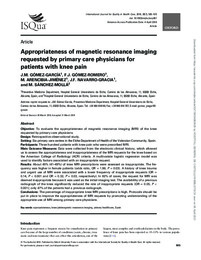Por favor, use este identificador para citar o enlazar este ítem:
https://hdl.handle.net/11000/37957Registro completo de metadatos
| Campo DC | Valor | Lengua/Idioma |
|---|---|---|
| dc.contributor.author | Gomez-Garcia, JM | - |
| dc.contributor.author | Gómez-Romero, Francisco Javier | - |
| dc.contributor.author | Arencibia Jiménez, Mercedes | - |
| dc.contributor.author | NAVARRO-GRACIA, J.F. | - |
| dc.contributor.author | Sánchez-Molla, Manuel | - |
| dc.contributor.other | Departamentos de la UMH::Medicina Clínica | es_ES |
| dc.date.accessioned | 2025-11-07T10:29:25Z | - |
| dc.date.available | 2025-11-07T10:29:25Z | - |
| dc.date.created | 2018-04 | - |
| dc.identifier.citation | International Journal for Quality in Health Care, 30(7), 565-570 - April 2018 | es_ES |
| dc.identifier.issn | 1464-3677 | - |
| dc.identifier.issn | 1353-4505 | - |
| dc.identifier.uri | https://hdl.handle.net/11000/37957 | - |
| dc.description.abstract | Objective: To evaluate the appropriateness of magnetic resonance imaging (MRI) of the knee requested by primary care physicians. Design: Retrospective observational study. Setting: Six primary care centres in the Elche Department of Health of the Valencian Community, Spain. Participants: Three hundred patients with knee pain who were prescribed MRI. Main Outcome Measures: Data were collected from the electronic clinical history, which allowed us to assess the appropriateness and inappropriateness of the MRI requests for the knee based on the American College of Radiology (ACR) criteria. A multivariate logistic regression model was used to identify factors associated with an inappropriate request. Results: About 45% (41–49%) of knee MRI prescriptions were assessed as inappropriate. The frequency was higher in female patients (odds ratio, OR = 1.96; P = 0.03). A history of knee trauma and urgent use of MRI were associated with a lower frequency of inappropriate requests (OR = 0.14, P < 0.001 and OR = 0.32, P = 0.03, respectively). In 82% of cases, the request for MRI was deemed inappropriate because it was used as the initial imaging test. The availability of a previous radiograph of the knee significantly reduced the rate of inappropriate requests (OR = 0.05, P < 0.001); only 47% of the patients had a previous radiograph. Conclusions: The percentage of inappropriate knee MRI prescriptions is high. Protocols should be put in place to improve the appropriateness of MRI requests by promoting understanding of the appropriate use of MRI among primary care physicians. | es_ES |
| dc.format | application/pdf | es_ES |
| dc.format.extent | 6 | es_ES |
| dc.language.iso | eng | es_ES |
| dc.publisher | Oxford University Press | es_ES |
| dc.rights | info:eu-repo/semantics/openAccess | es_ES |
| dc.rights | Attribution-NonCommercial-NoDerivatives 4.0 Internacional | * |
| dc.rights.uri | http://creativecommons.org/licenses/by-nc-nd/4.0/ | * |
| dc.subject | appropriateness | es_ES |
| dc.subject | knee jointmagnetic resonance imaging | es_ES |
| dc.subject | primary healthcare | es_ES |
| dc.subject | Spain | es_ES |
| dc.subject.other | CDU::6 - Ciencias aplicadas::61 - Medicina | es_ES |
| dc.title | Appropriateness of magnetic resonance imaging requested by primary care physicians for patients with knee pain | es_ES |
| dc.type | info:eu-repo/semantics/article | es_ES |
| dc.relation.publisherversion | https://doi.org/10.1093/intqhc/mzy067 | es_ES |

Ver/Abrir:
Appropriateness of magnetic resonance imaging requested by primary care physicians for patients with knee pain.pdf
232,72 kB
Adobe PDF
Compartir:
 La licencia se describe como: Atribución-NonComercial-NoDerivada 4.0 Internacional.
La licencia se describe como: Atribución-NonComercial-NoDerivada 4.0 Internacional.
.png)